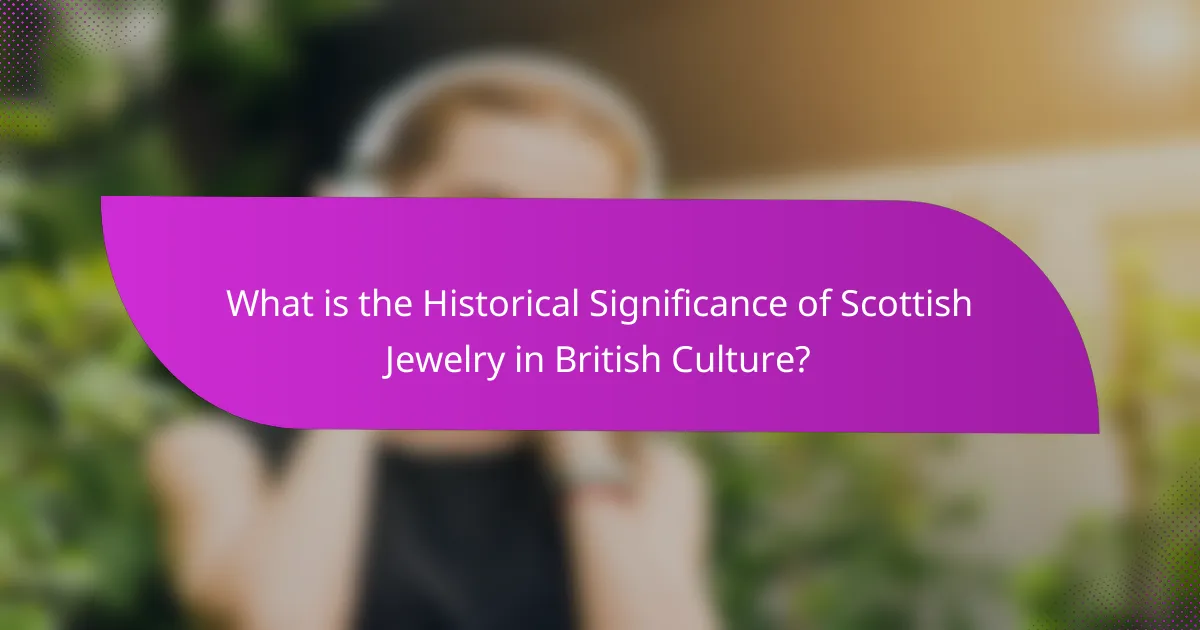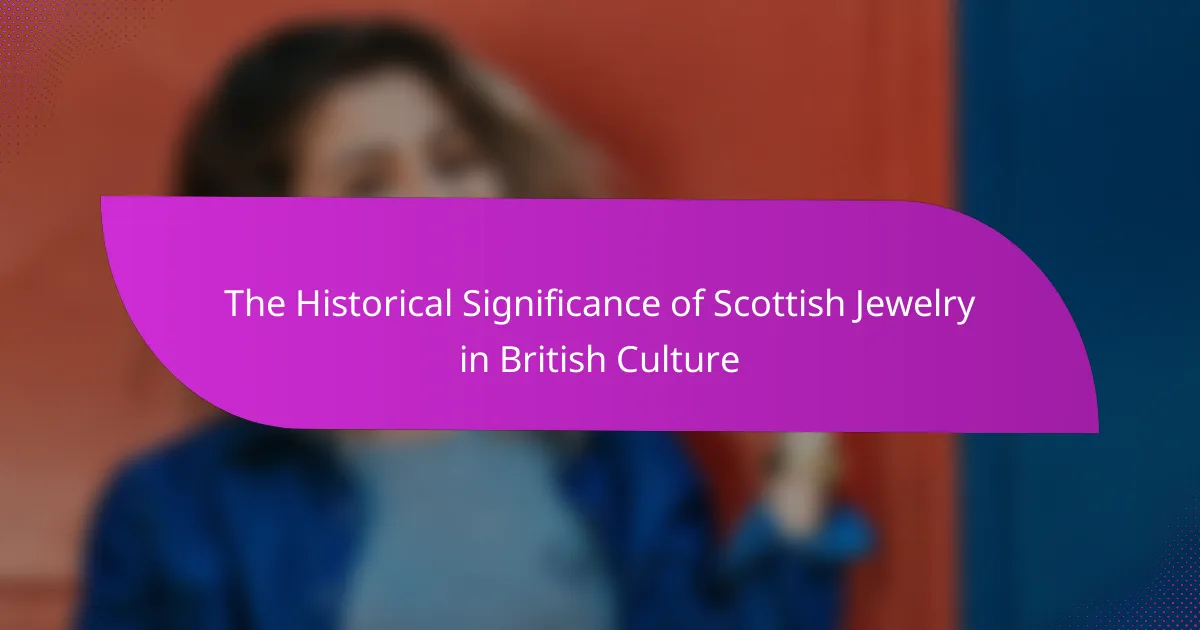Scottish jewelry is a significant cultural artifact within British heritage, characterized by its unique craftsmanship and symbolic designs that reflect Scotland’s history. Key motifs, such as thistles and Celtic knots, serve as representations of national pride and identity, historically worn by both men and women to signify status and clan affiliation. The craftsmanship, often utilizing local materials like silver and agate, emphasizes the connection to Scotland’s natural resources. The revival of interest in the 19th century, spurred by tourism, further solidified the importance of these jewelry pieces, which continue to preserve family and clan histories. Today, Scottish jewelry remains a vital aspect of cultural identity, showcasing its historical significance and artistry while appealing to both locals and visitors.

What is the Historical Significance of Scottish Jewelry in British Culture?
Scottish jewelry holds significant historical value in British culture due to its unique craftsmanship and cultural symbolism. The intricate designs often reflect Scotland’s heritage, including motifs like thistles and Celtic knots. These elements symbolize national pride and identity. Historically, Scottish jewelry was worn by both men and women, showcasing status and clan affiliation. The use of materials like silver and agate highlights the region’s natural resources. Jewelry pieces such as brooches and rings have been passed down through generations, preserving family and clan histories. The revival of interest in Scottish jewelry during the 19th century further solidified its importance in British culture. This period saw an influx of tourists, increasing demand for authentic Scottish artifacts. Overall, Scottish jewelry serves as a tangible connection to Scotland’s past and its influence on British identity.
How did Scottish jewelry evolve throughout history?
Scottish jewelry evolved significantly from ancient times to the present. Early examples include Celtic designs, characterized by intricate knotwork and symbolism. In the medieval period, jewelry often featured religious motifs and was made from gold and silver. The 19th century saw a revival of interest in Scottish heritage, leading to the popularity of unique pieces like the Scottish pebble jewelry. This style incorporated local stones, showcasing the natural beauty of Scotland. The Victorian era also influenced Scottish jewelry with the introduction of mourning pieces, often made from jet. Today, modern Scottish jewelry combines traditional techniques with contemporary designs, reflecting both history and innovation. The evolution of Scottish jewelry illustrates cultural shifts and regional identity throughout history.
What cultural influences shaped the design of Scottish jewelry?
Scottish jewelry design is shaped by Celtic, Norse, and Victorian influences. Celtic designs often feature intricate knotwork and symbolism, reflecting the region’s ancient heritage. Norse influence is evident in the use of animal motifs and bold geometric shapes. Victorian revival in the 19th century introduced romanticism and sentimental themes, incorporating gemstones and intricate craftsmanship. Each cultural influence contributes to the unique aesthetic of Scottish jewelry, showcasing a blend of history and artistry. This rich tapestry of influences creates a distinctive identity for Scottish jewelry within British culture.
What historical events impacted the production of Scottish jewelry?
The production of Scottish jewelry has been significantly impacted by various historical events. The Jacobite risings in the 18th century fueled a revival of Scottish identity and pride. This period saw an increase in the production of jewelry featuring Scottish symbols like thistles and clan crests. The Industrial Revolution also played a crucial role, as advancements in technology allowed for mass production of jewelry. Additionally, Queen Victoria’s fascination with Scotland in the 19th century popularized Scottish motifs in jewelry. The Great Exhibition of 1851 showcased Scottish craftsmanship to a wider audience, further boosting its appeal. Each of these events contributed to the evolution and prominence of Scottish jewelry in both local and international markets.
Why is Scottish jewelry considered important in British culture?
Scottish jewelry is considered important in British culture due to its rich heritage and unique craftsmanship. It reflects Scotland’s history, identity, and artistry. The use of traditional materials, such as silver and gemstones, showcases the skill of local artisans. Iconic pieces like the Scottish brooch and Celtic designs symbolize national pride. These items often feature motifs that tell stories of Scottish folklore and heritage. Additionally, Scottish jewelry has been worn by notable figures in British history, reinforcing its cultural significance. Its popularity has led to a revival in interest, making it a cherished element of British cultural expression.
What role did Scottish jewelry play in expressing national identity?
Scottish jewelry played a significant role in expressing national identity through its unique designs and symbols. The use of traditional motifs, such as the thistle and the saltire, reflects Scotland’s cultural heritage. Jewelry pieces, like the clan crest brooches, signify individual clan affiliations and pride. During the 19th century, the popularity of tartan patterns in jewelry further reinforced Scottish identity. Scottish jewelry became a means of showcasing national pride, especially during events like the Highland Games. The craftsmanship of Scottish jewelers also highlighted the country’s artistic traditions. Overall, Scottish jewelry serves as a tangible representation of Scotland’s rich history and cultural identity.
How has Scottish jewelry influenced British fashion trends?
Scottish jewelry has significantly influenced British fashion trends through its distinctive designs and cultural symbolism. The use of materials such as silver and gold, along with traditional motifs like thistles and Celtic knots, has made Scottish jewelry unique. This uniqueness has inspired British designers to incorporate these elements into mainstream fashion.
In the 19th century, the popularity of tartan patterns and Scottish-style brooches surged, especially during the Victorian era. Queen Victoria’s fascination with Scotland led to a revival of interest in Scottish jewelry. Her adoption of Scottish pieces set trends among the British elite.
Today, Scottish jewelry remains a source of inspiration for contemporary fashion designers. The blend of historical significance and modern aesthetics keeps Scottish jewelry relevant in British fashion.
What are the key features of traditional Scottish jewelry?
Traditional Scottish jewelry features intricate designs, often inspired by Celtic motifs. Common materials include silver, gold, and precious stones. Popular items include brooches, kilt pins, and rings. Many pieces showcase the use of tartan patterns or clan symbols. The jewelry often incorporates enamel work and filigree techniques. Historical significance ties these pieces to Scottish heritage and identity. Many designs date back to the Victorian era, reflecting a revival of interest in Scottish culture. Overall, traditional Scottish jewelry serves as a symbol of national pride and craftsmanship.
What materials are commonly used in Scottish jewelry?
Scottish jewelry commonly uses materials such as silver, gold, and gemstones. Silver is frequently employed for its malleability and luster. Gold is valued for its durability and aesthetic appeal. Gemstones like amethyst, garnet, and agate are often incorporated for color and symbolism. These materials reflect Scotland’s rich natural resources and cultural heritage. Historical records indicate that traditional Scottish jewelry often features Celtic designs. Such designs are deeply rooted in the country’s history and artistry.
What symbols and motifs are prevalent in Scottish jewelry designs?
Scottish jewelry designs prominently feature symbols and motifs such as the thistle, the Celtic knot, and the lion rampant. The thistle represents Scotland’s national identity and resilience. The Celtic knot symbolizes eternity and interconnectedness, reflecting the culture’s rich heritage. The lion rampant is a symbol of strength and bravery, often associated with Scottish royalty. Other common motifs include the saltire, or St. Andrew’s cross, representing Scotland’s patron saint. These symbols often appear in various forms of jewelry, including brooches, rings, and pendants. Their prevalence highlights the cultural significance and artistry within Scottish jewelry traditions.

How has Scottish jewelry been perceived in different eras?
Scottish jewelry has been perceived as a symbol of national identity throughout various eras. In the 18th century, it gained popularity as a representation of Scottish heritage during the Romantic movement. Jewelry pieces often featured motifs like thistles and clan symbols, reflecting a deep connection to Scottish culture. The Victorian era saw an increase in the production of Scottish jewelry, with intricate designs and the use of local materials like agate and silver. This period emphasized craftsmanship and sentimental value, as jewelry became a means of expressing love and loyalty. In the 20th century, Scottish jewelry evolved with modern influences, yet it retained its traditional elements. Today, it is celebrated for its artistry and historical significance, appealing to both locals and tourists. The enduring appeal of Scottish jewelry highlights its role in preserving cultural narratives across time.
What was the perception of Scottish jewelry during the Victorian era?
Scottish jewelry during the Victorian era was perceived as a symbol of national pride and identity. It gained popularity due to the revival of interest in Scotland’s cultural heritage. This jewelry often featured motifs inspired by nature, Celtic designs, and local materials like agate. The use of these elements resonated with the Victorian fascination for the romanticized past. Additionally, the jewelry was seen as a fashionable accessory among the upper classes. It was commonly worn during social events and gatherings. The perception was further enhanced by Queen Victoria’s affinity for Scottish culture, especially after her visits to Balmoral. This royal endorsement significantly influenced public interest and appreciation for Scottish jewelry during that time.
How did the Industrial Revolution affect Scottish jewelry craftsmanship?
The Industrial Revolution significantly transformed Scottish jewelry craftsmanship. It introduced mechanization, which increased production efficiency. Artisans could produce jewelry more quickly than before. This led to a rise in accessibility and affordability of jewelry items. Traditional handcrafting techniques were often replaced by machine-made processes. However, this also resulted in a decline in the unique artistry of individual pieces. The demand for mass-produced items grew, changing consumer preferences. Consequently, some traditional jewelers adapted by blending old techniques with new technologies. This period marked a pivotal shift in the industry, influencing the future of Scottish jewelry.
How is Scottish jewelry viewed in contemporary British culture?
Scottish jewelry is viewed as a symbol of cultural heritage in contemporary British culture. It reflects Scotland’s distinct identity and craftsmanship. Items like brooches and tartan designs are popular among both locals and tourists. The revival of interest in traditional crafts has increased its appreciation. Additionally, Scottish jewelry often signifies pride in Scottish history. Contemporary designers blend traditional styles with modern aesthetics. This fusion makes the jewelry relevant today. Events like the Edinburgh Festival showcase its cultural significance. Overall, Scottish jewelry is celebrated for its artistry and connection to Scottish traditions.
What modern trends are emerging in Scottish jewelry design?
Modern trends in Scottish jewelry design include the use of sustainable materials and contemporary aesthetics. Designers are increasingly incorporating eco-friendly practices into their work. This trend reflects a growing awareness of environmental issues among consumers. Additionally, there is a rise in the fusion of traditional Scottish motifs with modern designs. This blend appeals to both heritage enthusiasts and contemporary buyers. Unique craftsmanship remains a hallmark of Scottish jewelry, with artisans focusing on bespoke pieces. The integration of technology, such as 3D printing, is also becoming more prevalent. These trends indicate a dynamic evolution in the Scottish jewelry landscape, merging tradition with innovation.
How do contemporary artisans honor traditional Scottish jewelry techniques?
Contemporary artisans honor traditional Scottish jewelry techniques by incorporating historical methods and designs into their work. They often use materials like silver and gold, which have been staples in Scottish jewelry for centuries. Many artisans study ancient patterns and motifs, such as Celtic knots and thistles, to create authentic pieces. They also employ traditional techniques like hand engraving and enameling, which were commonly used in historical pieces. Some artisans participate in workshops and training programs to learn from master craftsmen. This commitment to skill preservation ensures that traditional techniques are not lost. Additionally, contemporary pieces often tell stories of Scottish heritage, connecting past and present. This approach maintains cultural significance while appealing to modern aesthetics.

What impact does Scottish jewelry have on cultural heritage today?
Scottish jewelry significantly impacts cultural heritage today by preserving traditional craftsmanship and identity. It reflects Scotland’s history and artistry, showcasing unique designs like the Claddagh ring and Celtic knots. These pieces often symbolize love, loyalty, and friendship, enhancing their cultural value. The revival of interest in Scottish jewelry has led to increased tourism and local craftsmanship. Events like Highland Games and Scottish festivals promote these traditions. Additionally, contemporary designers incorporate historical elements, bridging past and present. This fusion keeps cultural narratives alive, ensuring they remain relevant in modern society.
How does Scottish jewelry contribute to cultural tourism in Scotland?
Scottish jewelry significantly contributes to cultural tourism in Scotland by attracting visitors interested in its unique heritage. The craftsmanship of Scottish jewelry often reflects traditional designs, such as Celtic knots and clan symbols. These designs resonate with tourists seeking authentic cultural experiences.
Events like the Edinburgh Festival and local markets showcase Scottish jewelry, enhancing its visibility. Tourists often purchase these pieces as tangible souvenirs of their visit. The jewelry also tells stories of Scotland’s history and identity, deepening visitors’ cultural understanding.
According to VisitScotland, cultural tourism has been a growing sector, with jewelry playing a pivotal role in this trend. The distinctiveness of Scottish jewelry helps differentiate Scotland from other destinations. This unique cultural artifact fosters a connection between tourists and Scotland’s rich traditions.
What events and festivals celebrate Scottish jewelry and craftsmanship?
Events and festivals that celebrate Scottish jewelry and craftsmanship include the Edinburgh Craft Beer Festival and the Scottish Craft Fair. The Edinburgh Craft Beer Festival showcases local artisans, including jewelers. The Scottish Craft Fair features a wide range of crafts, highlighting traditional Scottish jewelry. Additionally, the Glasgow School of Art hosts exhibitions focusing on jewelry design. These events promote local craftsmanship and cultural heritage. They attract artisans and visitors interested in Scottish jewelry. Each festival provides a platform for showcasing unique designs and techniques.
What are some tips for preserving and caring for Scottish jewelry?
To preserve and care for Scottish jewelry, store it in a cool, dry place. Avoid exposure to moisture and humidity. Clean the jewelry regularly with a soft cloth to remove dirt and oils. Use mild soap and water for deeper cleaning, but avoid harsh chemicals. Inspect the jewelry for loose stones or damage periodically. Handle the pieces gently to prevent bending or breaking. When wearing, avoid contact with perfumes or lotions. Lastly, consider professional cleaning and maintenance for intricate designs.
How can one maintain the quality and appearance of Scottish jewelry over time?
To maintain the quality and appearance of Scottish jewelry over time, regular cleaning is essential. Use a soft cloth to gently wipe the jewelry after each wear. This removes oils and dirt that can cause tarnishing. Store the jewelry in a dry, cool place to prevent damage from humidity. Avoid exposure to harsh chemicals and perfumes that can harm the metal and stones. For intricate pieces, consider professional cleaning annually. This helps preserve their intricate designs and luster. Following these practices can significantly extend the lifespan of Scottish jewelry.
What storage methods are best for protecting Scottish jewelry pieces?
The best storage methods for protecting Scottish jewelry pieces include using soft pouches, acid-free boxes, and humidity-controlled environments. Soft pouches prevent scratches and damage during storage. Acid-free boxes protect against tarnishing and corrosion. Humidity-controlled environments help maintain the integrity of delicate materials like silver and gemstones. These methods are recommended by jewelers and conservators to ensure the longevity of valuable jewelry. Proper storage can significantly reduce wear and tear, preserving the historical significance of these pieces.
Scottish jewelry is a significant entity in British culture, known for its unique craftsmanship and cultural symbolism. The article explores its historical evolution, key features, and the cultural influences that shaped its design, highlighting the importance of motifs like thistles and Celtic knots. It discusses the impact of historical events, such as the Jacobite risings and the Industrial Revolution, on jewelry production and perception. Additionally, the article examines contemporary trends, preservation methods, and the role of Scottish jewelry in cultural tourism, underscoring its enduring significance in expressing national identity and heritage.
